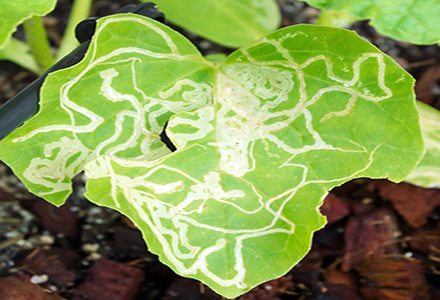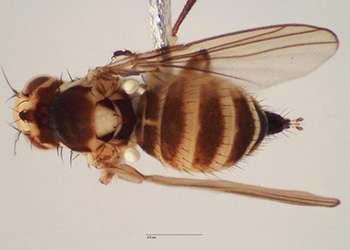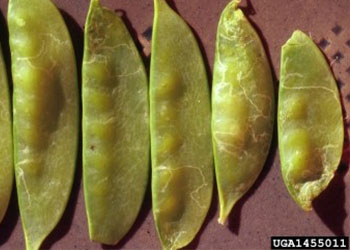PLANT PEST

Exotic leaf miner species
Two species are exotic to Australia and three of the National Priority Plant Pest species are now established
Features: Tiny insects whose larvae cause damage by tunnelling through the inside of leaves leaving a meandering track
Where they're from: North, Central America and Caribbean, South America, Europe, Africa, Asia, Oceania
How they spread: Importation of infested plants or cut flowers; pupa in soil; locally by flying
At risk: A large number of species including melons, vegetables, onions, grains, cotton, ornamentals and production nurseries
Leaf miners damage leaves by feeding inside them leaving squiggly trails.
Scot Nelson, Flickr.
Keep them out
Leaf miners are tiny greyish black flies about 2 mm long. Their larvae (grubs) feed under the surface of leaves. This causes loss of healthy leaf tissue, so the plant can’t capture enough sunlight and often becomes infected with disease. Plants often fail to grow or produce crops.
While there are over 300 leaf miner species worldwide, five species are considered to be serious pests:
- serpentine leaf miner (Liriomyza huidobrensis) (present in Australia)
- vegetable leaf miner (Liriomyza sativae) (present in Australia)
- American serpentine leaf miner (Liriomyza trifolii) (present in Australia).
Leaf miners threaten Australia’s vegetable, potato, melon, cotton, onion and grain crops as well as production nurseries.
Importing goods
To keep leaf miners out of Australia, never ignore Australia’s strict biosecurity rules.
Import shipments may need to be treated and certified, so before you import, check our Biosecurity Import Conditions system (BICON).
Stop the spread
The vegetable leaf miner, serpentine leaf miner, and American serpentine leaf miner are natives of the Americas and have spread to most parts of the world. These species are now found in some areas of Australia. Biosecurity measures and quarantine restrictions are in place to limit their spread.
Travelling interstate
Interstate travellers have a role to play in preventing the spread of established leaf miners. Before you travel interstate or move house, look up your journey on the Australian Interstate Quarantine website to see the restrictions that apply.
Do not enter farms without permission.
What to look for
- Trails or 'mines'—light green to white squiggles—on leaf surfaces.
- Sometimes a blackened stripe at the tunnel edge.
- Trails get wider as the grubs grow.
- Adult leaf miners are tiny flies—just 1–2 mm in length. Their colour varies with the particular species.
While similar damage could be caused by other leaf mining insects that are already in Australia, if you see squiggly leaf miners, particularly on a number of species of plant, don’t hesitate to report it.


Where to look
Importers
Importation of infested plants, plant material or soil is the most likely way that leaf miners could make it to Australia.
Growers and home gardeners
Look out for the tell-tale squiggly trails in crops and garden plants including:
- tomato leaf miner (not present in Australia) – in many vegetables, mainly tomatoes
- chickpea leaf miner (not present in Australia) – in legumes, mainly chickpeas
- serpentine leaf miner (established in Victoria, Queensland and New South Wales) – 15 plant families, including beet, spinach, peas, beans, potatoes and cut flowers
- vegetable leaf miner (established in far north Queensland and Torres Strait) – 40 hosts in 10 plant families, including capsicum, melon, cucumber, carrot and lettuce
- American serpentine leaf miner (established in Queensland and Western Australia) – 28 plant families, including soybean, cotton, pea, potato and eggplant.
What to do
If you think you’ve found leaf miner trails or insects which could either be caused from an exotic or extension of range:
- take a photo
- contain the insects if possible (this may be as simple as closing the doors on a shipping container or preventing access to a vegetable plot).
